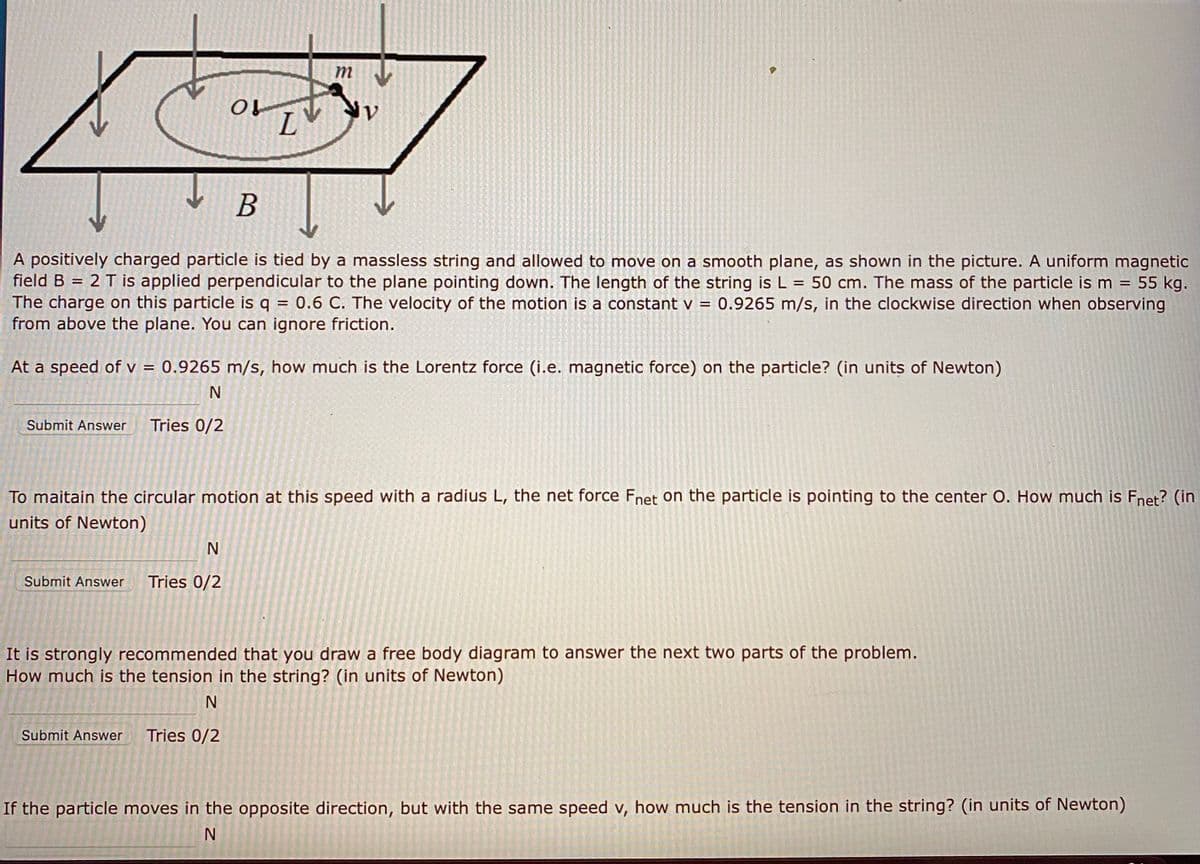m 10 B A positively charged particle is tied by a massless string and allowed to move on a smooth plane, as shown in the picture. A uniform magnet field B = 2 T is applied perpendicular to the plane pointing down. The length of the string is L = 50 cm. The mass of the particle is m = 55 k The charge on this particle is q = 0.6 C. The velocity of the motion is a constant v = 0.9265 m/s, in the clockwise direction when observing from above the plane. You can ignore friction. At a speed of v = 0.9265 m/s, how much is the Lorentz force (i.e. magnetic force) on the particle? (in units of Newton) Submit Answer Tries 0/2 To maitain the circular motion at this speed with a radius L, the net force Fnet on the particle is pointing to the center O. How much is Fnet? units of Newton) Submit Answer Tries 0/2 It is strongly recommended that you draw a free body diagram to answer the next two parts of the problem. How much is the tension in the string? (in units of Newton) Submit Answer Tries 0/2 If the particle moves in the opposite direction, but with the same speed v, how much is the tension in the string? (in units of Newton)
m 10 B A positively charged particle is tied by a massless string and allowed to move on a smooth plane, as shown in the picture. A uniform magnet field B = 2 T is applied perpendicular to the plane pointing down. The length of the string is L = 50 cm. The mass of the particle is m = 55 k The charge on this particle is q = 0.6 C. The velocity of the motion is a constant v = 0.9265 m/s, in the clockwise direction when observing from above the plane. You can ignore friction. At a speed of v = 0.9265 m/s, how much is the Lorentz force (i.e. magnetic force) on the particle? (in units of Newton) Submit Answer Tries 0/2 To maitain the circular motion at this speed with a radius L, the net force Fnet on the particle is pointing to the center O. How much is Fnet? units of Newton) Submit Answer Tries 0/2 It is strongly recommended that you draw a free body diagram to answer the next two parts of the problem. How much is the tension in the string? (in units of Newton) Submit Answer Tries 0/2 If the particle moves in the opposite direction, but with the same speed v, how much is the tension in the string? (in units of Newton)
Principles of Physics: A Calculus-Based Text
5th Edition
ISBN:9781133104261
Author:Raymond A. Serway, John W. Jewett
Publisher:Raymond A. Serway, John W. Jewett
Chapter22: Magnetic Forces And Magnetic Fields
Section: Chapter Questions
Problem 80P
Related questions
Question

Transcribed Image Text:m
LV
A positively charged particle is tied by a massless string and allowed to move on a smooth plane, as shown in the picture. A uniform magnetic
field B = 2 T is applied perpendicular to the plane pointing down. The length of the string is L = 50 cm. The mass of the particle is m = 55 kg.
The charge on this particle is q = 0.6 C. The velocity of the motion is a constant v = 0.9265 m/s, in the clockwise direction when observing
from above the plane. You can ignore friction.
%3D
At a speed of v = 0.9265 m/s, how much is the Lorentz force (i.e. magnetic force) on the particle? (in units of Newton)
%3D
Submit Answer
Tries 0/2
To maitain the circular motion at this speed with a radius L, the net force Fnet on the particle is pointing to the center O. How much is Fnet? (in
units of Newton)
Submit Answer
Tries 0/2
It is strongly recommended that you draw a free body diagram to answer the next two parts of the problem.
How much is the tension in the string? (in units of Newton)
N
Submit Answer
Tries 0/2
If the particle moves in the opposite direction, but with the same speed v, how much is the tension in the string? (in units of Newton)
Expert Solution
This question has been solved!
Explore an expertly crafted, step-by-step solution for a thorough understanding of key concepts.
This is a popular solution!
Trending now
This is a popular solution!
Step by step
Solved in 2 steps with 1 images

Knowledge Booster
Learn more about
Need a deep-dive on the concept behind this application? Look no further. Learn more about this topic, physics and related others by exploring similar questions and additional content below.Recommended textbooks for you

Principles of Physics: A Calculus-Based Text
Physics
ISBN:
9781133104261
Author:
Raymond A. Serway, John W. Jewett
Publisher:
Cengage Learning

College Physics
Physics
ISBN:
9781305952300
Author:
Raymond A. Serway, Chris Vuille
Publisher:
Cengage Learning

College Physics
Physics
ISBN:
9781285737027
Author:
Raymond A. Serway, Chris Vuille
Publisher:
Cengage Learning

Principles of Physics: A Calculus-Based Text
Physics
ISBN:
9781133104261
Author:
Raymond A. Serway, John W. Jewett
Publisher:
Cengage Learning

College Physics
Physics
ISBN:
9781305952300
Author:
Raymond A. Serway, Chris Vuille
Publisher:
Cengage Learning

College Physics
Physics
ISBN:
9781285737027
Author:
Raymond A. Serway, Chris Vuille
Publisher:
Cengage Learning

Physics for Scientists and Engineers
Physics
ISBN:
9781337553278
Author:
Raymond A. Serway, John W. Jewett
Publisher:
Cengage Learning

Physics for Scientists and Engineers with Modern …
Physics
ISBN:
9781337553292
Author:
Raymond A. Serway, John W. Jewett
Publisher:
Cengage Learning
